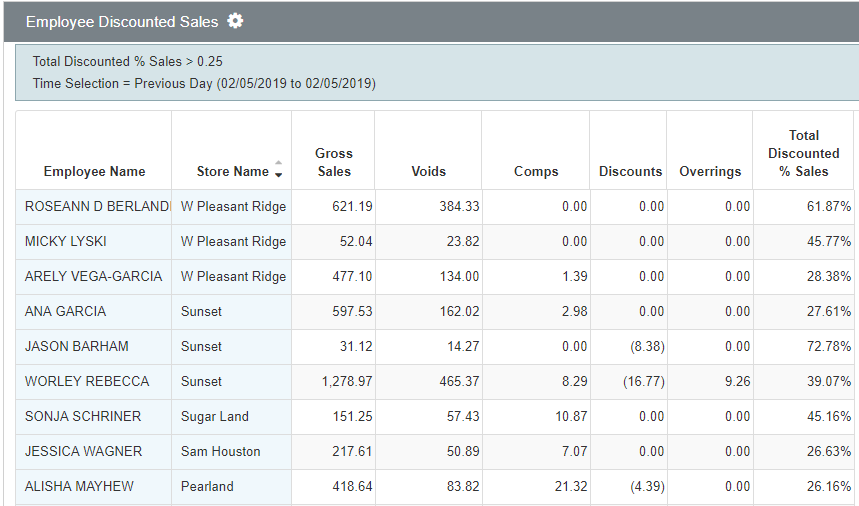
Employees Learn Quick
Voids, Comps, and other means to adjust orders in process, just placed or delivered are a necessity if you operate a restaurant. Let’s face it, employees can make mistakes while entering orders just as customers can change their minds and now want a different item or realize they don’t have enough cash and now need to pay with a credit card. On the other hand, if you just tendered a customer's order to cash, you’ll need to void the order and re-enter using the new tender type.
Of course, these are just two of many examples where voids are a requirement. Comps on the other hand are used in the restaurant business when the wrong item was delivered or the customer was unhappy with their experience. While these tools are available to make corrections and adjustments as needed – your employees learn quickly that they can just as easily be manipulated to their financial advantage.
While theft is an area many restaurateurs prefer not to discuss, it doesn’t mean it’s not happening in their restaurants. In fact, the NRA did a study and concluded that restaurant loss due to fraud runs on average around 4% of sales. Couple this with the incredibly narrow margins restaurants operate on and one can see why it’s important to take this seriously and implement the controls needed to minimize your losses.
Restaurant Employee Theft Types
As you might suspect, there’s no lack of creativity when it comes to theft, which simply means there’s more ways it can occur in your restaurant than you might imagine.
Here’s a few examples:
- Employee not ringing up a sale and keeps cash
- Adding unearned tips to checks
- Applying coupons to cash checks
- Clocking in early or clocking out late
- Selling your own inventory of items
- Reusing the same check
- Stealing silverware and glassware
- Managers floating cash from deposits
- Stealing gift certificates or gift cards
- Managers adding discounts to checks at close
- Walking out with food or liquor
- Under portioning and keeping the extra sale
It’s not my intent to try and cover each way a restaurant can be losing money, rather, I’ll focus on the king of restaurant losses - cash theft. Here again, there are a number of ways cash theft can occur, but the focus of this article is on two of the more popular methods – voids and comps. So, before we talk about the fraud potential of each, let’s take a quick look at what constitutes a void VS. a comp and how each can be used to steal from your restaurant.
Void
In the context of point-of-sale and accounting systems, the term void is a transaction which cancels, or deletes entirely, a previously completed transaction. The distinction is that the transaction being voided is one that was already completed, versus one that is still in the process of being made.
NOTE: Depending on your POS system Void may actually be called; Cancel, Over-ring, Delete, Clear, etc. Voids are a necessity. For example, an employee takes an order and the customer changes their mind and if servers are voiding items that are delivered to the customer instead of recording them as a comp, you will reduce your gross food sales which makes it appear that the sale never happened, and this makes it ideal for theft to occur - let's take a closer look at how that might happen.
In many restaurants the server has the authority to remove/void an item from a check. In these situations, it’s possible for a server to charge a customer the full amount for their order, but subsequently void items from the ticket and pocket the cash. For example, a customer orders three items for a final bill of $25. The customer then leaves behind $30 cash on the table for the bill and tip.
The employee then voids out one of the items, bringing the total down to $18. Thus, the server pockets the extra $7 plus the original $5 tip, and the register still reflects the correct amount of cash-based sales.
Comp
Comps are items taken off the bill on products that have been delivered. For example, the wrong drink was made and delivered to the guest. Or, you gave away a drink to a guest for any number of reasons such as they’re a regular in your restaurant or you’re making up for a problem that occurred.
NOTE: Comps may also be called Discounts and depending on how comps are accounted for or not in your accounting system, they can have an impact on your income statement.
Regardless of what your Voids are actually called or how your Comps are handled after the fact, if they’re being manipulated by your servers or managers to their financial gain, they’ll each have a direct impact on your bottom line. This makes it important to have a plan of action and a means to easily and more quickly identify those employees that may be stealing – after all, as Ben Franklin said; “Time is money.”
Preventing Restaurant Theft
Now that we’ve identified two of the ways theft can occur the question is what do you do to get ahead of it before it really impacts your bottom line. Well, as we mentioned earlier, one indicator will be an unexplained increase in your food costs. While this early notification is great, I liken it to being more like smoke on the horizon – you know there’s a fire but you don’t know its origin or how big it might be or what you need to do to put it out. So, you need more insight before you can successfully put it out. To do that you need check level detail – that’s every line item, on every check from every location every day and as you likely know that’s a lot of information. Of course, there are any number of tools that can help narrow this down but in the end it’s still going to take resources and time to sort through and come to any conclusions and in today’s tight labor pool how many companies have extra resources they can dedicate to this effort.
Solution - Exception-Based Reporting
So, the best way to minimize the time needed to detect fraud while maximizing your ability to combat it is by using the data your point-of-sale system makes available (check level detail) and then combine it with an exception-based reporting technique to narrow the list down to just those who, among your staff (cashiers, servers, managers) are most likely stealing.
Exception-Based Reporting is done by establishing a set of filters (what's acceptable/unacceptable to your company) that are then applied to the check level detail to produce exceptions. For example, a company may determine that it's unacceptable to have more than 0.25 of every dollar voided, etc., from any check. You may have hundreds of team members working for your company that handle cash but by filtering the results there may only be a handful that match or exceed the criteria you established - now that's a lot more manageable than trying to look at every person.
Example

Prevent Employee Voids & Comps
As seen in the example above, once the filter is applied to the check detail, a list of individuals who exceed this level (the exceptions) will be produced. This limits the number of individuals that will need further review. To summarize, Exception-Based Reporting helps narrow your search which means more of your team’s time is spent executing and less time is spent collecting and reviewing information.
What Exception-Based Reporting Users Say
Why are the exceptions so important?
"The exceptions could be something like a comp or a void, something that’s been deleted. It might be lots of dollars on the table that we wouldn’t catch. Today we’ve written alerts that show things like people with more than 5 comps in one day or more than a certain dollar threshold. We use red, yellow and green KPI indicators to make it stand out. You can’t do that in most computer systems, but you can with an exception or an alert of some sort. It’s like an alarm clock for your data, for the important stuff."
How has catching these exceptions impacted your company?
"The loss prevention side of our business has dropped a whole lot. It’s a lot easier to catch employees when they steal. The word gets out when someone gets caught and the other employees realize they shouldn’t do it. It keeps the honest people honest. Over time we’ve lowered our comps and deletes by over 2 percentage points of our P&L, especially in the first 2 years. At that time it was probably $100,000/year that we were catching and lowering in comps. An ROI of 10 times what we were spending on Mirus." - Business Analyst, Tumbleweed Tex Mex Grill
Conclusion
While it’s not realistic to think you can prevent all theft in every location, it is realistic to think you can minimize this activity by actively monitoring check level detail. You can start by monitoring discounts, voids, over-rings, and any other means your POS system allows money to be removed from a check.
Next, setting a threshold for what’s acceptable (everyone makes a mistake and needs to make a correction on a check) or reasonable will allow you to focus on cashiers and managers exhibiting behavior that’s inconsistent with the threshold you’ve set. In the beginning, you should keep an eye and make sure the threshold is doing a reasonable job and adjust as necessary.
Over time, you’d want to try and lower it – again keeping an eye to make sure you’re not flagging everyone. The goal here is to slowly tighten up the level of acceptability to further minimize theft. In summary, capturing your check level detail in a comprehensive, exception-based reporting and analytic solution like Mirus will transform your data into a powerful tool to help you combat many of the ways cash theft can occur.
Are you able to easily and quickly identify the potential theft issues in your restaurants?
About Mirus:
Mirus provides services in data management and solutions in custom reporting for the restaurant industry.
Learn more at mirus.com
Watch Mirus demo and client insight videos on our YouTube Channel
If you enjoyed this blog, please share it by using the social buttons at the top of the page and leave your thoughts in the comment section below.









.png?width=50&height=50&name=Mirus%20Logo%20(1).png)